CRANE Thesis Documentation Chapter 3 | Methodology
This chapter of CRANE Thesis Documentation Chapter 3 | Methodology it presents the system design and methodology of the proponent’s game. A condition will be set on the software based on the usage of the software. T
hen, the features of the software are determined based on the needs. Next, a data flow diagram is created to determine the flow of data from server to user.
The software development tools is chosen based on the limitation and features. Then, the software flow chart is created based on the limitation and features.
Here’s the Outline of CRANE Thesis Documentation Chapter 3 | Methodology
1. Methodology
2. System Development Life Cycle(SDLC)
3. CRANE Use Case Model
4. Activity Diagram
5. Context Diagram
6. Dataflow Diagram
7. Entity Relationship Diagram
8. Data Dictionaries
9. Screen Design
10. Architectural Diagram
11. Hardware and Software Requirements
12. References
Methodology
This chapter 3 presents the system design of the proponent’s system
CRANE Thesis Documentation Chapter 3 | Methodology : System Development Life Cycle(SDLC)
The System Development Life Cycle is a framework defining tasks performed at each step in the software development process. It is a structure followed by a development team with in the software organization.
It consists of a detailed plan describing how to develop, maintain and replace the specific software. The life cycle defines the methodology for improving the quality of the software and over all development process.
The proponents will use the Agile Model application development methodology as a guide of processing the game flow.
CRANE Thesis Documentation Chapter 3 | Methodology : Agile Development Methodology
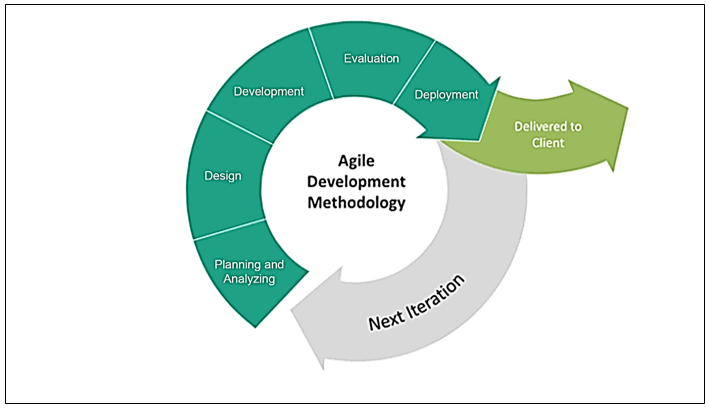
Figure 1 Shows the Agile Development Diagram used by the proponents as their model for developing the game. It shows how the research and process is being implemented from the start of the process until it will finish.
Agile shows that every project needs to be handled differently and the existing methods need to be tailored to best suit the project requirements. In Agile, the tasks are divided to time boxes (small time frames) to deliver specific features for a release.
In Addition, the proponents believed that every project needs to handle differently based on existing method and project requirement.
Iterative approach is taken and working software build is delivered after each iteration. Each build is incremental in terms of features; the final build holds all the features required by the end-user.
Planning and Analyzing
In this phase, the proponents will analyze the data they’re going to gather and create a design that is suitable for the process for Coordinated Response Authority for National Emergencies” or C.R.A.N.E.
Design
After planning and analyzing, the proponents will design the game with some criteria that require with their user.
Development
In this phase, the proponents will do the coding and developing of the game interfaces. The proponents will use Unity for the implementation of the game.
Database design will also take part in this phase. The combination of Unity & MySQL will form the complete game architecture with their functions.
Evaluation
Evaluation is phase to test the game after process planning and design. If any error surfaces during testing, the proponents will repair it until it functions properly.
One of the advantages of using Agile Method is that a developer can return to any phase that needs repairing without having to go back to the first stage.
Deployment
Deployment is the last phase in the game, if the game is stable and shows no signs of errors, the proponents will proceed with the next phase of the project. The cycle repeats until all required features are complete.
CRANE Thesis Chapter 3 | Methodology : CRANE Use Case Model
Figure 2 show the general use case of the Coordinated Response Authority for National Emergency. It also shows what the player can interact with (Start game & Manage Settings).

Figure 3 show the player to expect when the player wants to play the game.
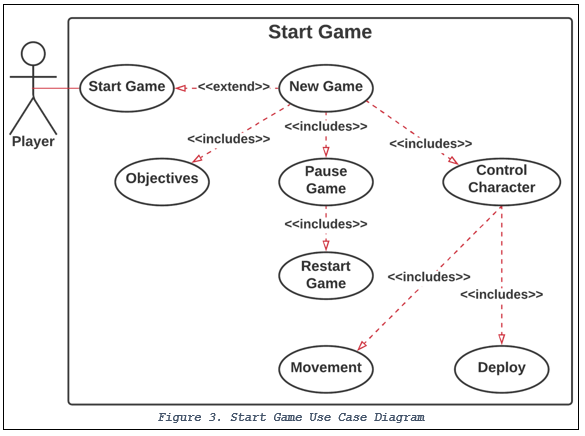
Table 2. Start Game Use Case Description
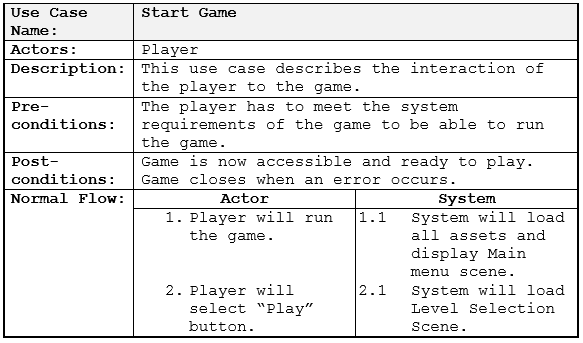
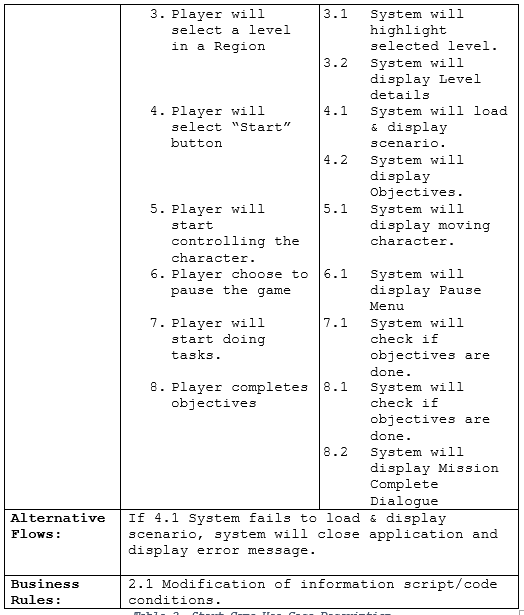
CRANE Thesis Chapter 3 | Methodology : Manage Setting

Figure 4 shows how can player manage in-game settings.
Table 3. Option Menu Use Case Description
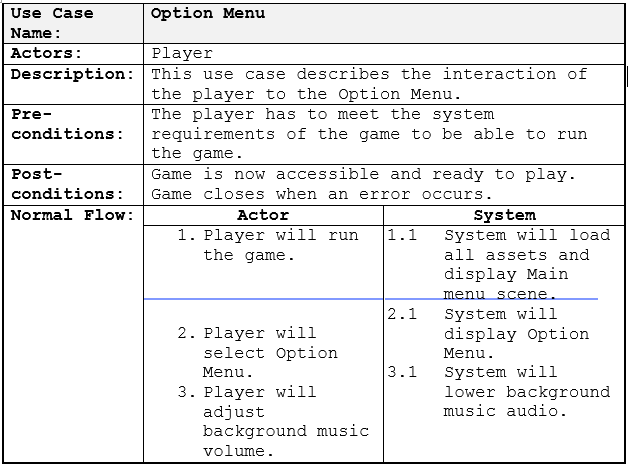
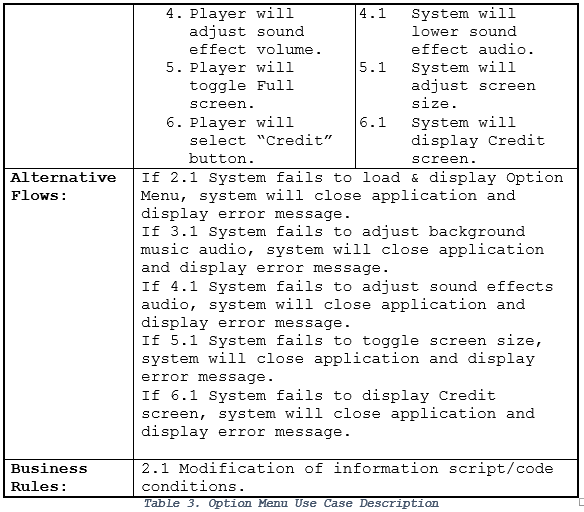
Table 3 shows the flow and the functions of settings in the game.
CRANE Thesis Chapter 3 | Methodology : Activity Diagram
Game Interface

Figure 5. Shows the interaction between the user and the game in the menu interface.
CRANE Thesis Chapter 3 | Methodology : In Game
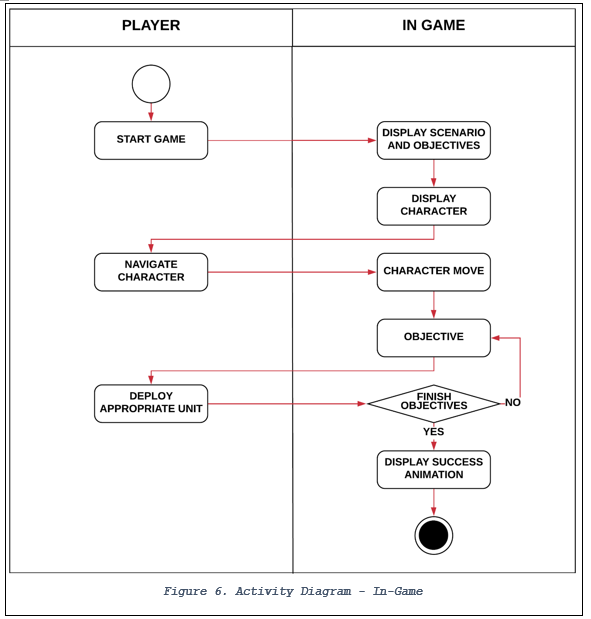
Figure 6. Illustrates the interaction between the user and the game during in-game.
CRANE Thesis Chapter 3 | Methodology : Architectural Design
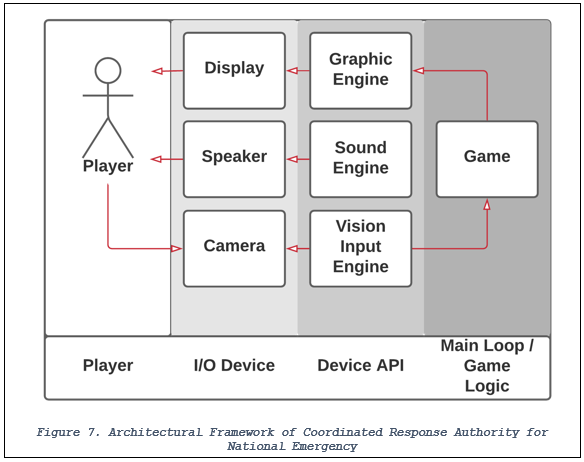
Figure 7 shows the architectural framework of the game and how thing interconnect with each other thru external mediums.
CRANE Thesis Chapter 3 | Methodology : Screen Layout and Design

Figure 8 shows the logo of the Coordinated Response Authority for National Emergency – C.R.A.N.E.
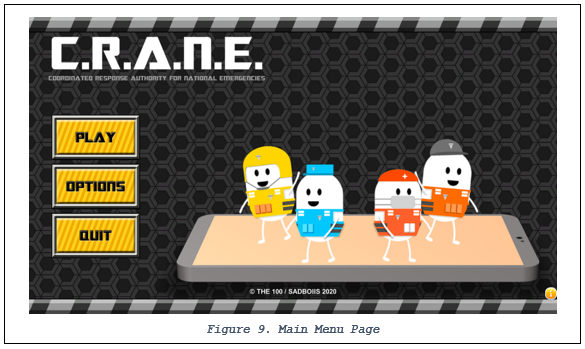
Figure 9 shows the main menu page. It consists of Play, Options to adjust the background music and sound effects of the game, and Quit button.
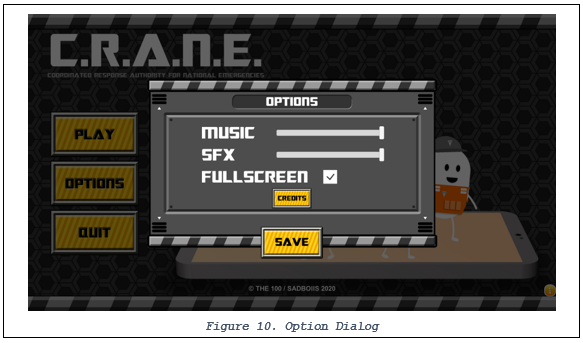
Figure 10 shows the background music, sound effects and the full screen toggle. It also shows the credits about the developers.

Figure 11 shows the project manager of the game and its members.
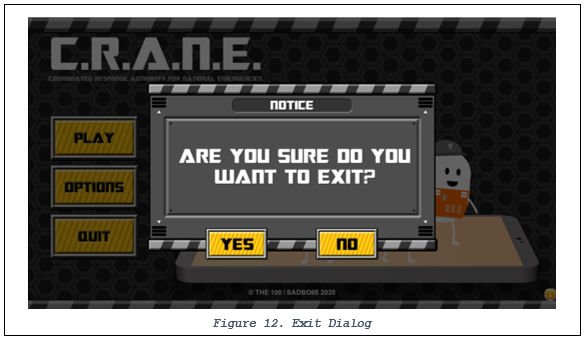
Figure 12 shows the quit dialog of Coordinated Response Authority for National Emergency.
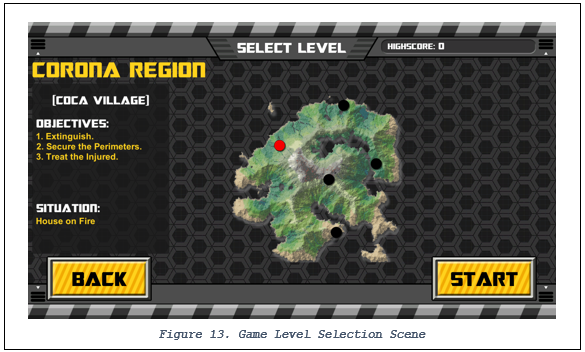
Figure 13 shows the whole map of the game and details about the level.
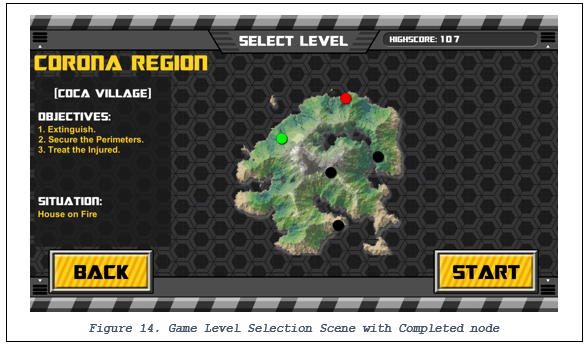
Figure 14 shows the whole map of the game with a completed node or level and details about the level.

Figure 15 shows the loading screen of the game with safety reminders and tips for the game below.

Figure 16 shows the actual game interface of the Coordinated Response Authority for National Emergencies.
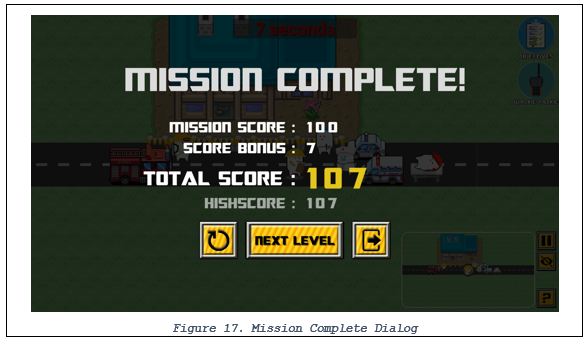
Figure 17 shows the mission complete dialog and score summary when you successfully finish all the objectives.

Figure 18 shows the mission fail dialog when you fail to finish all the objectives.

Figure 19 shows the instructions on how to play the game.
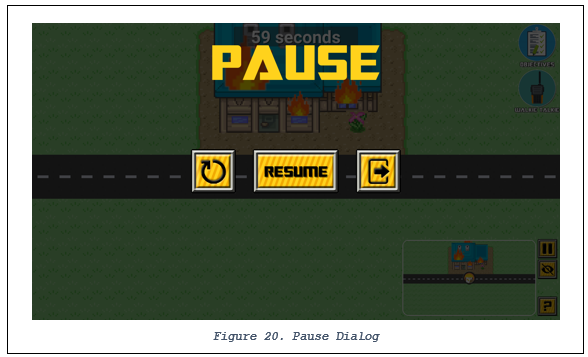
Figure 20 shows the pause dialog of the game.
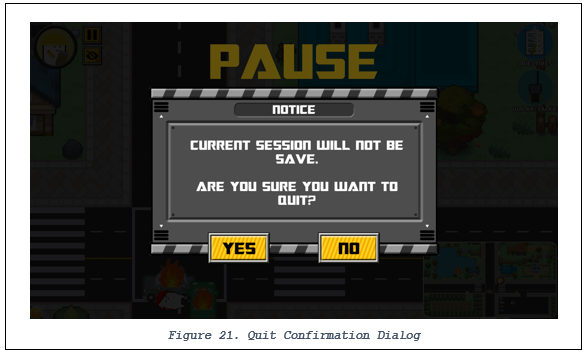
CRANE Thesis Chapter 3 | Methodology : Hardware and Software Used for Developing the Game
Hardware Specifications for Developing the game:
The hardware specifications for this project work are stated as follow:
- Processor : AMD Ryzen 5 2600 Six-Core
Processor 3.40 GHz
- System Type : 64-bit Operating System
- Memory (RAM) : 16.00 Gb
- Hard disk : 1 Tb
Software Specifications for developing the game:
The software requirement for developing the system includes:
- Window 10 Pro Operating System
- Unity 2D 2019
- XAMPP Version 7.4.11
System Requirements to install the game:
The hardware specifications for this project to work properly are stated as follow:
Minimum Requirements:
- Processor : Intel® Core™2 Duo or greater
- OS : Windows 7, Windows 8, Windows 10
- System Type : 32-bit Operating System
- Memory (RAM) : 2 Gb
- Hard disk : 250 Mb
Recommended Requirements:
- Processor : Intel® Core™2 Duo
- OS : Windows 7, Windows 8, Windows 10
- System Type : 64-bit Operating System
- Memory (RAM) : 4.00 Gb or greater
- Hard disk : 500 Mb or greater
CRANE Thesis Chapter 3 | Methodology : Respondents of the study
Respondents of the study is composed of two groups; the IT Experts and End-Users. The proponents came up with 5 Experts composed of IT instructors, Game Developers and Responders. And 10 end-users composed of game enthusiasts as respondent of the study.

Table 4 shows the number of respondents of the Coordinated Response Authority for National Emergencies.
CRANE Thesis Chapter 3 | Methodology : Research Instrument
Data Analysis
After collecting all the survey form, the proponents used an appropriate descriptive statistical tool. Mean was used to determine the perception of the respondents of the game.
In interpreting the derived weighted mean, the verbal interpretation in Table 4 was used.
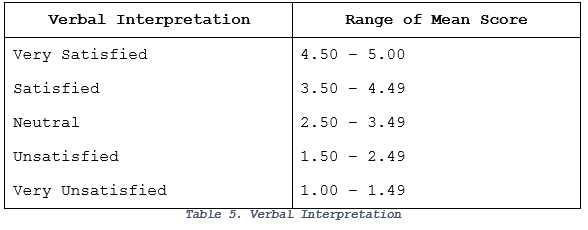
Table 5 shows the verbal interpretation of the corresponding mean scores.
CRANE Thesis Chapter 3 | Methodology : Gantt Chart

Figure 22 shows the list of tasks with allocated time to complete the task.
CRANE Thesis Chapter 3 | Methodology : Time Table


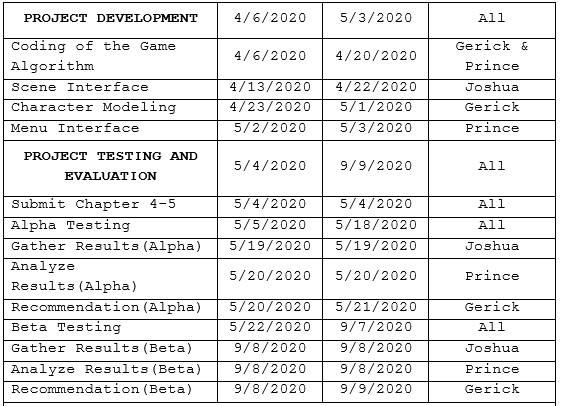

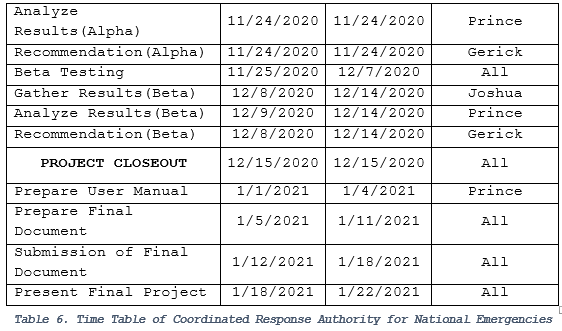
Figure 6 shows the Time Table of the proponents.
Related Article
- Pharmacy Management System Thesis | Chapter 3 – Methodology
- Online Restaurant Management System Documentation Chapter 3
- Sales and Inventory System Documentation Chapter 3
- Library Borrowing System Documentation | Chapter III – Methodology
- Attendance Monitoring System Documentation | Chapter 3
Inquiries
if you have any questions or suggestions about CRANE Thesis Chapter 3 | Methodology, please let’s me know by dropping your comment below.

